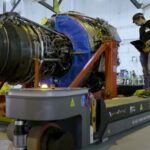Step into the future of aviation with the revolutionary Airbus A390 concept – a groundbreaking aircraft that promises to redefine long-haul travel. This innovative triple-decker design could transform how we traverse continents, offering unprecedented passenger capacity and cutting-edge technology. Let’s explore what makes this conceptual marvel a potential game-changer in commercial aviation.
The Airbus A390 emerges as the world’s largest passenger jumbo jet concept, representing a bold leap forward in commercial aviation. This hypothetical extension of the Airbus family builds upon the successful legacy of the A380, pushing engineering boundaries to new heights.
As a next-generation solution for international air travel, the A390 concept addresses the growing demand for efficient mass transportation across continents. Its unprecedented capabilities could potentially reshape airline fleet strategies and airport infrastructure requirements, demonstrating Airbus’s commitment to aviation innovation.
Design and Features of the A390
- Revolutionary 3-decker design expanding vertical space
- Capacity for up to 1,000 passengers in various class configurations
- Advanced Rolls Royce jet engines specially designed for increased payload
- Distinctive “beluga whale” profile with expanded upper fuselage
- Cutting-edge materials and aerodynamic innovations
- Eight-deck interior layout with enhanced amenities
- Advanced avionics systems for improved pilot control
- Next-generation entertainment systems and improved cabin pressurization
Variants: A390-800 and A390-900
| Feature | A390-800 | A390-900 |
|---|---|---|
| Design Type | Baseline Model | Extended Variant |
| Target Market | Airlines replacing aging widebody fleets | Ultra-high capacity routes |
| Key Feature | Operational flexibility | Maximum passenger capacity |
Performance and Capabilities
- Range: approximately 7,500 miles for non-stop global connectivity
- Runway requirement: minimum 3,800 meters (12,500 feet)
- Advanced multi-wheel landing gear system
- Specially developed Rolls Royce engines with optimal fuel consumption
- Compatible with existing major international airports
Fuel Efficiency and Environmental Impact
The A390 concept showcases remarkable environmental innovations, promising up to 24% reduction in per-passenger fuel consumption compared to current generation aircraft. This efficiency stems from advanced aerodynamic design, next-generation composite materials, and cutting-edge engine technology.
- 100% compatibility with sustainable aviation fuels (SAF)
- 30% reduction in noise footprint compared to A380
- Advanced acoustic linings in engine nacelles
- Optimized departure procedures for noise reduction
- Improved carbon footprint per passenger-mile
Market Adoption and Key Customers
Major global carriers have shown significant interest in the A390 concept, particularly those operating high-density routes between major international hubs. The aircraft’s appeal is strongest in the Asia-Pacific region and among Middle Eastern carriers with ambitious expansion plans. Its superior capacity and operational economics make it especially attractive for airlines operating from congested hub airports, potentially reducing daily flight frequencies while maintaining passenger throughput.
Launch and Delivery Timeline
Lufthansa, Germany’s flagship carrier, has emerged as the frontrunner for the Airbus A390 program by securing a preliminary order for one aircraft. This strategic positioning aligns with their historical role as pioneers in adopting new aircraft types, including their early embrace of the A380. Their commitment serves as a crucial catalyst for initial production and market confidence.
Emirates, currently dominating the A380 market, has shown substantial interest in becoming the primary customer for the A390 program. Their Dubai-based hub strategy perfectly complements the aircraft’s high-capacity design. Industry projections suggest the following timeline:
- Initial program approval and development phase: 2025-2028
- First test flights and certification: 2028-2030
- Inaugural delivery to Lufthansa: early 2030s
- Emirates fleet deployment: mid-2030s
- Global operator expansion: late 2030s
Challenges and Incidents
The A390 project faces considerable hurdles, particularly given the A380’s limited commercial success. The viability of a triple-deck configuration raises significant questions in today’s environmentally conscious aviation landscape, demanding unprecedented fuel efficiency without compromising payload capacity.
Two significant test flight incidents have shaped the aircraft’s development:
| Incident | Issue | Impact |
|---|---|---|
| Iberia Flight 3481 (2022) | Critical hydraulic system failure | Revealed design weaknesses in hydraulic redundancy |
| American Airlines Flight 6798 | Severe turbulence | Exposed structural integrity concerns in upper deck connections |
Safety Measures and Improvements
- Implementation of quadruple hydraulic redundancy systems
- Enhanced structural connections using advanced carbon composites
- Establishment of dedicated Advanced Safety Analysis Unit
- Next-generation emergency evacuation systems
- Rapid-deploy external slides for 90-second full evacuation
These comprehensive safety enhancements demonstrate Airbus’s commitment to learning from previous incidents while advancing commercial aviation capabilities. The data-driven approach, utilizing sophisticated computer modeling for thousands of potential failure scenarios, ensures robust safety measures before physical testing begins.
The Future of Large Aircraft
The aviation industry faces a pivotal moment in large aircraft development. Following the A380’s mixed success, Airbus must carefully navigate the development of ambitious concepts like the A390. The market increasingly demands aircraft that balance capacity with operational efficiency and flexibility.
Two opposing forces shape the future of large aircraft:
- Growing preference for point-to-point travel
- Persistent congestion at major international hubs
- Need for higher-capacity aircraft on specific routes
- Demand for improved fuel efficiency
- Requirements for operational flexibility
Comparisons with Airbus A380
The A380’s legacy presents both lessons and challenges for the A390 concept. Despite being an engineering marvel and passenger favorite, the A380’s production ended after just 251 deliveries, far below the 400-unit break-even point.
| Aspect | A380 Experience | A390 Requirements |
|---|---|---|
| Passenger Experience | Industry benchmark | Must exceed current standards |
| Operational Efficiency | Limited by high costs | Revolutionary efficiency improvements needed |
| Airport Compatibility | Restricted operations | Enhanced flexibility required |
Public Perception and Marketing Potential
The A390 concept has already ignited significant public interest, despite existing only in preliminary designs. Aviation enthusiasts across social media platforms actively engage in discussions and create unofficial renderings of this revolutionary aircraft, demonstrating an organic marketing momentum that Airbus could potentially harness during development stages.
Marketing potential for the A390 can be analyzed through several key aspects:
- Brand ambassador potential for operating airlines
- Distinctive competitive advantage opportunities
- Premium service differentiation capabilities
- Unique onboard experience possibilities
- Natural social media engagement and buzz generation
| Marketing Aspect | Expected Impact |
|---|---|
| Social Media Presence | High organic engagement and viral potential |
| Airline Branding | Enhanced premium positioning opportunities |
| Passenger Appeal | Strong aspirational travel experience factor |
Drawing from the A380’s success as a marketing tool, particularly with Emirates, the A390 presents even greater opportunities for airlines to create distinctive brand experiences. The unprecedented interior volume would enable carriers to develop unique onboard offerings, potentially attracting passengers specifically seeking to experience this next-generation aircraft. This phenomenon, previously observed with both the A380 and Boeing 747, suggests that revolutionary aircraft designs can evolve beyond mere transportation to become coveted travel experiences in their own right.

